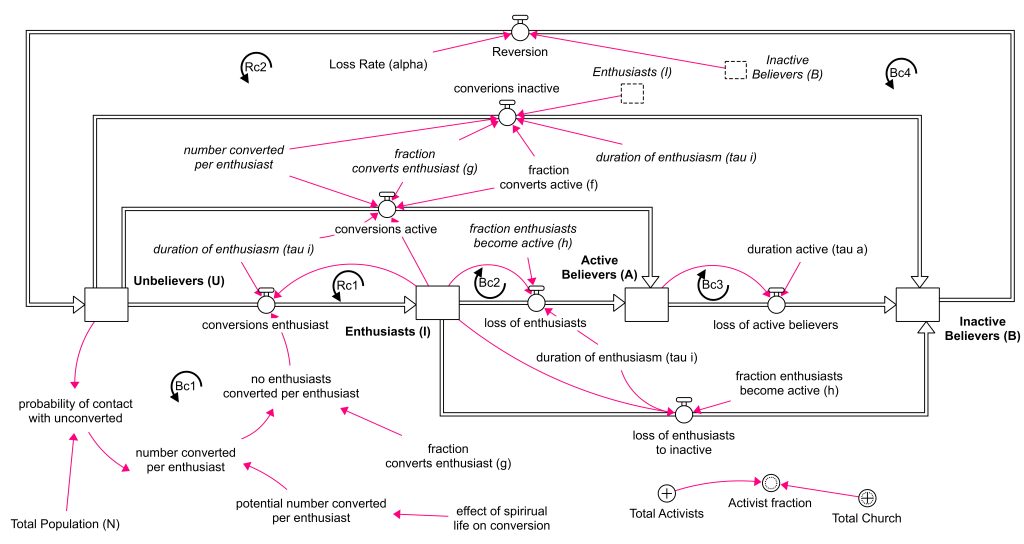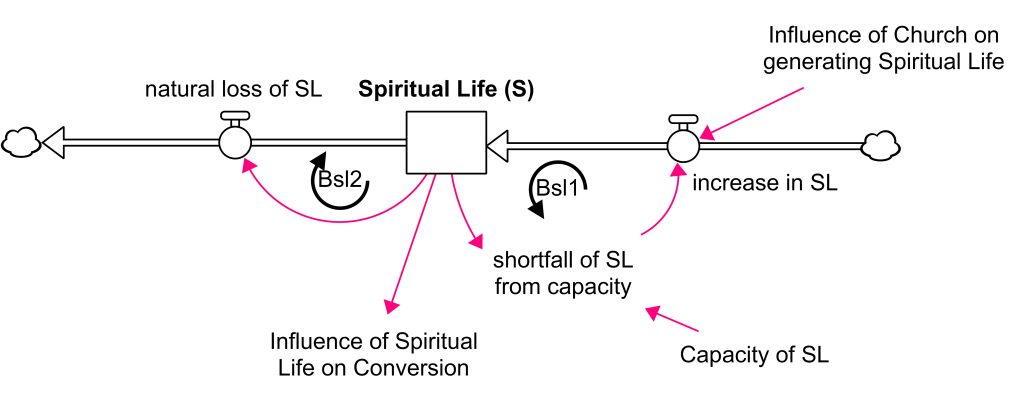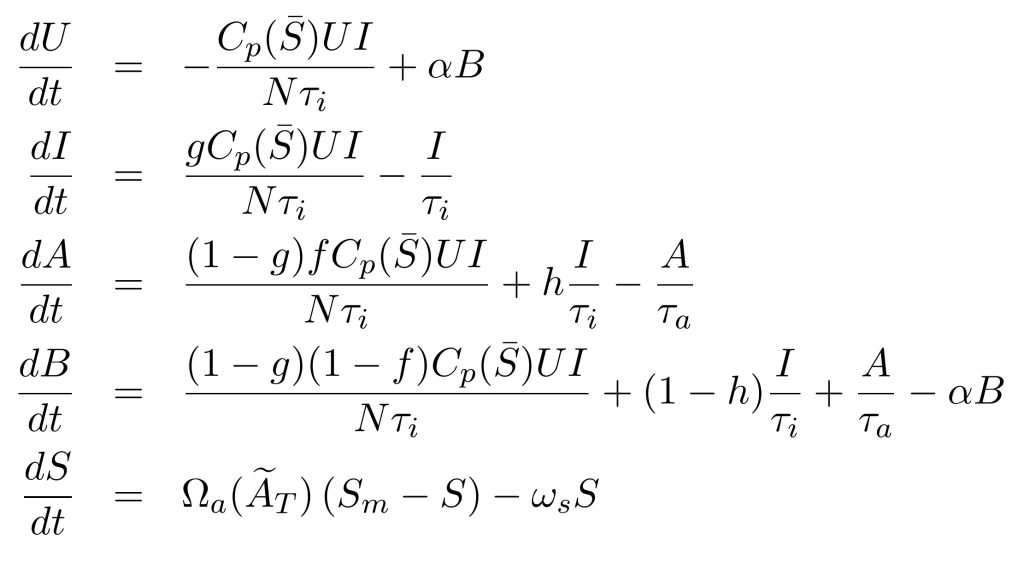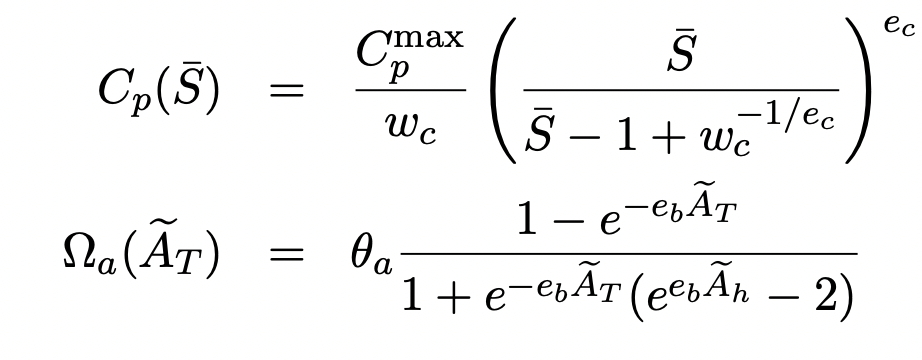The central hypothesis of the limited enthusiasm model is that a subgroup of church members, enthusiasts, drives the church’s conversion growth. If some new converts become new enthusiasts, reproduction occurs, and the church continues to grow.
The Spiritual Life model extends the limited enthusiasm model by allowing a wider group of activists to generate spiritual life within the church, which can, in turn, enhance the effectiveness of the enthusiasts as agents of conversion. The analogy is with the spread of a disease, where the enthusiasts are “infected” believers passing the faith on to unbelievers who catch the “disease” of religion. In this model, the infectiousness of the “religious disease” can vary due to the activity of church members.
The following model details supplement the Spiritual Life through Activists Model Overview.
- Assumptions
- System Dynamics Model
- Dynamic Hypotheses
- Equations
- What is Meant by Spreading the Faith?
- What is Meant by Spiritual Life?
- How Do Enthusiasts Generate Spiritual Life?
- Why Does Spiritual Life Enhance Growth?
- Why Does Spiritual Life Fade?
- Demographics
- Model Results
Assumptions
The model consists of four groups of people: unbelievers, enthusiasts who are solely responsible for spreading the faith, active believers or activists who help generate spiritual life within the church, and inactive believers. If demographic effects are included, then unbelievers are split into those open to conversion and those hardened against it.
The spiritual life model is built on the limited enthusiasm model with activists and the Demographics models, providing fuller details of these assumptions.
There is an additional variable called Spiritual Life. This is a measure of the level of spiritual life of all the activists, including the enthusiasts. This concept is measured by the spiritual life in each individual, averaged over the whole group. Furthermore, it also measures the spiritual life of the church, as activists influence church life.
Spiritual life will include activities such as prayer, worship, discipleship and teaching, as well as internal spiritual inclinations and feelings that may drive behaviour. Because the effects of these quantities overlap, they cannot be easily separated. Further, they cannot be accurately measured in terms of quantity or quality. Thus, Spiritual life may be reduced to a single variable. Think of it like a “spiritual temperature” that measures how “hot” the church is in terms of the things that matter most in the spiritual side of its beliefs.
Spiritual life is related to the sociologists’ concept of spiritual capital, which is a spiritual version of social capital: the collective benefits that individuals derive from working together. That is, networks have more value than the sum of their individual components. In the case of spiritual capital, the church has more spiritual value than its individual members alone, because interacting within a network yields greater spiritual benefits for members. Spiritual capital is more specific than religious capital, as the latter may include rituals and acts that offer little or no spiritual benefit.
Spiritual life is an example of a “soft variable”, one that can be understood conceptually but is hard to measure. They are often measured subjectively by comparison with past estimates. Thus, more people praying or running Bible studies will make the church a more “spiritual” place than it was before. More spiritual life will mean that the church has more to offer people seeking God and something different to offer from non-religious organisations and society. Thus, they could see more converts. Spiritual life is thus understood in terms of what produces it and how it affects other things, both of which are easier to measure. For this reason, it is given a maximum value, which can be taken as 100%. Thus, spiritual life will become harder to achieve as it approaches that maximum.
System Dynamics Model
Unbelievers convert to believers through contact with enthusiasts who have “spread the faith” to them. New converts become enthusiasts. Enthusiasts only remain active for a limited length of time. Subsequently, they may remain activists, building a spiritual life, but not spreading the faith. Eventually, they become inactive and take no further part in making the church lively. Inactive believers may leave the church and be open to “re-conversion”, i.e. rejoining the church. Activists generate spiritual life in the church, which in turn makes enthusiasts more effective in conversion. See the module outline in figure 1.

The population module contains the population stocks, including those of the church, figure 2. This stock-flow model excludes the full demographic effects for the sake of clarity. Growth is driven by enthusiasts, Rc1, and opposed by the diminishing pool of susceptibles, Bc1, as in the basic Limited Enthusiasm Model. Additionally, the impact of the enthusiasts is reduced by their limited enthusiastic period, Bc2. The impact of activists is reduced by their limited active period, Bc3. However, an additional reinforcing loop, R1, figure 1, accelerates church growth as groups of enthusiasts increase in their spiritual life and hence in their effectiveness. It is this variability in the enthusiasts’ effectiveness that is the primary focus of this model.

The growth of spiritual life is opposed as that life fades in individuals, Bsl2, figure 3. As spiritual life approaches its maximum value, its growth is increasingly opposed by loop Bsl1. Spiritual life has been modelled by a single stock. However, more sophisticated models are possible.

The loop Rc2, figure 1, enables the model to have a long-term application and illustrates generational cycles of growth that result from people leaving the church, Bc4, as in the Demographics Model.
Dynamic Hypotheses
The dynamic hypotheses are:
| DYNAMIC HYPOTHESIS | DESCRIPTION |
|---|---|
| Conversion Through Enthusiasts (Rc1) | Enthusiasts are responsible for spreading the faith, i.e. conversion to the church. The more they convert, the more enthusiasts. This accelerates growth. Spreading the faith can be done by numerous means. |
| Loss of Enthusiasm (Bc2) | After a period of time, enthusiasts lose their potential to convert. This slows and limits growth. |
| Diminishing Susceptible Pool (Bc1) | As people are converted, the effectiveness of the enthusiasts on the remaining unbelievers decreases, as proportionally more of the enthusiasts’ time is spent on believers. This slows growth. |
| Loss of Activism (Bc3) | After a period of time, activists lose their potential to produce spiritual life. This slows and limits spiritual life. |
| Believers Leave Church (Bc4) | Believers can leave the church and become unbelievers again, in the sense that they no longer belong to the church. |
| Leavers May Return to Church (Rc2) | People who leave the church may return, but only through contact with an enthusiast. They are indistinguishable from unbelievers |
| Growth Enhanced Through Spiritual Life (R1) | The communal action of enthusiasts generates spiritual life. This, in turn, enhances their effectiveness in conversion. |
| Spiritual Life Fades (Bs2) | Spiritual life naturally fades in the individual and thus in the church, unless there is some activity by enthusiasts to maintain it. |
| Spiritual Life has an Upper Limit (Bs1) | Spiritual life has a maximum value due to the limited capacity of people. The spiritual life of the church is the average value over the enthusiasts, not the total, and is thus also limited. It will become increasingly harder to increase as it approaches capacity. |
| Demographics | There are further assumptions connected with births, deaths, leaving the church, reversion, softening and hardening of unbelievers, as in the Demographics model. |
Equations
The system dynamics model can be reduced to a set of ordinary differential equations.

where U, I, A, B, S are unbelievers, enthusiasts, active believers, inactive believers and spiritual life respectively. N is the total population. f is the fraction of converts who become active, g is the fraction of converts who become enthusiasts, and h the fraction of existing enthusiasts who become active rather than inactive. τa is the period that activists are active, and τi is the period that enthusiasts are active. α is the leaving rate. ωs is the natural decay rate of spiritual life, and Sm is the maximum possible value of spiritual life.
Cp is the conversion potential. Ωa is the generation rate of spiritual life. Both represent transmission functions, describing how spiritual life influences conversion, and the church generates spiritual life. They are given by:

Cp is a function of spiritual life on a scale of zero to 1. Ωa is a function of the proportion of total activists (A + I) in the church.
Transmission functions like these adjust the shape of the response curve. Thus, the response does not have to be linearly proportional to the cause. The sensitivity in the middle range may differ from that in the low and high ranges. Cp has an upper limit of Cpmax. Responses are controlled by elasticities ec and eb with weight wc. Ah is the proportion of activists in the church that gives a response of half the maximum response.
What is Meant by “Spreading the Faith”?
All aspects of conversion and spreading the faith are discussed in the limited enthusiasm model.
- What is meant by spreading the faith?
- How is the faith Spread?
- Why do enthusiasts stop spreading the faith?
- Why do some converts never spread the faith?
- Why do enthusiasts spread the faith less as the church grows?
What is Meant by Spiritual Life?
Spiritual life is a property of a single person, normally a Christian believer, in the context of church growth modelling. It may also be seen as a property of a church, represented as an average group of believers acting together as one.
Spiritual life is that aspect of a believer’s life that helps them have a greater understanding and practice of the spiritual aspects of the Christian faith. Thus, the primary consequence of that life is that a believer is better able to pass the faith on to unbelievers. A second consequence is that the believer is better equipped to build up the spiritual life of the church, that is, other believers.
For more details, see Spiritual Life in Dynamic Modelling.
How Do Activists Generate Spiritual Life?
There are both natural reasons, which could be true of any organisation, and also reasons that depend on God’s action. However, these two types of reasons overlap in their effects. Thus, they are presented here without any attempt to separate them.
- Activists, including enthusiasts, are able to encourage each other and spur each other on in zeal for building a lively church and making converts:
- Enthusiasts report back the stories of their attempts to win people to Christ;
- New enthusiasts bring fresh life and zeal to the group;
- Activists plan together how to make a better church and have a more effective witness;
- They help each other in their own personal faith, admonish, correct and inspire;
- Activists are better able to hold to the fundamentals of the faith, maintaining a strong and strict church, following Kelley’s Thesis;
- Activists pray together, and God answers their prayers:
- God releases his Spirit on the church, increasing every believer’s spiritual life and giving spiritual gifts;
- God makes changes in the personal lives of the activists, making them more like Christ;
- The Lord releases his presence, creating a state of heaven on earth that empowers activists to build a better church and enthusiasts to take on the world in witness;
- Activists are better able to build up the rest of the church because there are more of them.
Why Does Spiritual Life Enhance Growth?
- Believers who are more like Christ are more likely to attract people to the faith ;
- A church whose life is spiritual, portrays God better and is more likely to attract people. It will keep an unbeliever long enough so that they become converted. Better churches have more impact;
- The God who moves in the hearts of believers, making them better enthusiasts, also opens the hearts of unbelievers to respond. Enthusiasts are effective because God is effective in the lives of those who witness AND those they witness to;
- Enthusiasts become more active as God’s presence empowers them to take on the world;
- A stronger and stricter church creates a more transparent church, better able to present its beliefs and more able to win and keep those who identify with those beliefs.
Why Does Spiritual Life Fade?
Unless any belief is reinforced, its importance in a person’s life will diminish. Put another way, to be a Christian, a person needs to practice Christianity. This is why it is so hard to be a Christian without being a part of a church or some organised group. For beliefs to be maintained, time needs to be devoted to them; otherwise, the mind’s natural tendency to forget takes over. Spiritual life is no different. Unless there are “things happening” in a person’s life to increase the spiritual side of life, such as prayer, Bible study, interaction with others, and worship, then that life will fade by neglect. When this life is aggregated across all believers in the church, then the net result is that the church’s spiritual life also fades. Thus, teaching programmes, evangelism, and keeping worship fresh are all part of maintaining the church’s spiritual health.
Demographics
All demographic aspects are discussed in the demographics model.
- Why Do People Leave the Church?
- How Do the Children of Believers Become Part of the Church?
- Why Do the Children of Believers Fail to Become Part of the Church?
- Why Do Unbelievers Harden or Soften?